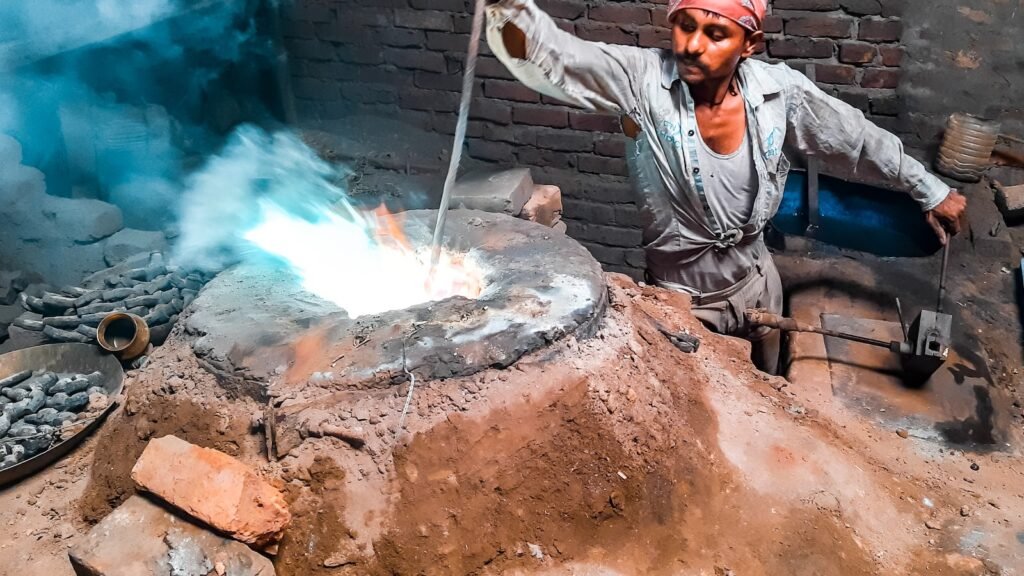Dive into the intricate world of metal stamping and discover the step-by-step journey of transforming metal sheets into precision components. How does a simple metal sheet evolve into a meticulously crafted part? Let’s unravel the production cycle of metal stamping.
The metal stamping production cycle is a systematic process that involves several stages, from initial design and material selection to the final stamped product. This cycle ensures that each metal component is produced with utmost precision, consistency, and quality.
Join us as we delve deeper into each phase of the metal stamping production cycle, shedding light on the intricacies, techniques, and technologies that shape this fascinating manufacturing process.

Introduction to Metal Stamping
Metal stamping, a cornerstone in the manufacturing world, is a process that transforms flat metal sheets into specific shapes. It’s a technique that has been around for centuries, evolving with technological advancements and catering to the dynamic needs of various industries. From the automotive sector to electronics, metal stamping’s footprint is ubiquitous, underscoring its pivotal role in producing a myriad of components that drive our modern world.
The production cycle in metal stamping is not just about transforming a metal sheet; it’s a meticulous journey that ensures precision, consistency, and quality. A well-defined production cycle is paramount, as it dictates the efficiency of the process, the quality of the output, and the overall cost-effectiveness of the operation.
The Essence of Metal Stamping
So, what exactly is metal stamping? At its core, metal stamping is a cold-forming process that employs dies and punches to shape metal sheets. The metal, which is placed between the die and the punch, is shaped when the punch is activated and pushes the metal into the die cavity, crafting it into the desired shape.
The role of dies and machinery in this process cannot be overstated. Dies, which are custom-made for each project, determine the shape, size, and features of the stamped part. They come in various types, from simple to complex, catering to a wide range of applications. The machinery, on the other hand, provides the necessary force to ensure the metal conforms to the die’s design. Together, they form the heart and soul of the metal stamping process, ensuring each stamped component meets the exact specifications and standards set by the industry.

Stages of the Metal Stamping Production Cycle
The metal stamping production cycle is a meticulously orchestrated sequence of steps, ensuring that each metal component is crafted with precision, consistency, and efficiency. Let’s delve into the stages that define this transformative journey.
Design and Prototyping
Before any metal is shaped, the journey begins with an idea. This conceptual phase involves visualizing the final product, understanding its functionality, and determining its specifications. Once the concept is clear, prototypes are created. These are preliminary versions of the product, allowing manufacturers to test and refine their designs. Prototyping is crucial as it provides insights into potential flaws, areas of improvement, and the feasibility of the design in a real-world scenario.
Material Selection
The choice of metal plays a pivotal role in the stamping process. Different metals have varied properties, and the selection often depends on the intended use of the stamped part. Factors such as strength, malleability, corrosion resistance, and cost influence this decision. For instance, automotive industries might prioritize strength and durability, while electronics might lean towards metals with good conductivity.
Die Development
The die is the heart of the stamping process. It’s a custom-made tool that gives the metal its shape. Designing the die involves intricate planning, ensuring it aligns perfectly with the product’s specifications. Once designed, the die is manufactured, often using high-grade steel to withstand the pressures of stamping. Before it’s put to use, the die undergoes rigorous testing to ensure precision and quality in the stamping process.
Actual Stamping Process
With the die ready, the actual stamping begins. Metal sheets are fed into the stamping machine, where they meet the die. Using powerful presses, the metal is subjected to operations like punching, where holes are created; bending, where the metal is angled; and embossing, where patterns are imprinted. Each operation is carried out with precision, ensuring the metal transforms into the desired shape.
Post-Stamping Operations
Once the metal is stamped, the process isn’t over. The stamped parts often undergo trimming to remove excess material. They are then shaped further, if necessary, and finished to enhance their appearance and protect against corrosion. Finally, each part undergoes quality checks and inspections. This ensures that every component meets the set standards and is ready for its intended use.

Technological Advancements in Metal Stamping
In an era where technology is reshaping industries, metal stamping is no exception. The traditional methods, while effective, are now being augmented with cutting-edge technologies, ensuring greater precision, efficiency, and adaptability. Let’s explore how these technological marvels are redefining the landscape of metal stamping.
Automation in Metal Stamping
Automation has been a game-changer in the manufacturing sector, and metal stamping has embraced it wholeheartedly. Automated stamping presses, feeders, and transfer systems have made the production process faster and more consistent. With automation, the need for manual interventions is reduced, leading to fewer errors and increased production rates. Moreover, automation allows for real-time monitoring and adjustments, ensuring that each stamped part adheres to the highest quality standards.
The Role of Artificial Intelligence (AI)
AI is not just a buzzword; it’s a transformative force in metal stamping. By leveraging machine learning algorithms, stamping machines can now predict and prevent potential issues before they arise. For instance, AI can analyze patterns and detect anomalies in the stamping process, prompting timely interventions. Furthermore, AI-driven predictive maintenance can forecast when a machine or die might need servicing, reducing downtimes and ensuring uninterrupted production.
The Horizon of Emerging Technologies
Beyond automation and AI, the future holds immense promise with the advent of other technologies. Augmented Reality (AR) and Virtual Reality (VR) are set to revolutionize design and prototyping, allowing engineers to visualize and test designs in a virtual space before actual production. Additionally, the integration of the Internet of Things (IoT) means machines are more connected than ever, enabling seamless data exchange, remote monitoring, and enhanced process optimization.

Conclusion
Metal stamping, a craft refined over centuries, stands as a testament to human ingenuity and the relentless pursuit of precision. As we’ve journeyed through its intricate production cycle, it’s evident that each stage, from design to post-stamping operations, is a harmonious blend of art and science. This meticulous process ensures that every metal component crafted not only meets but often exceeds the expectations set for it.
But as with all crafts, metal stamping is not static. It evolves, adapts, and grows. The infusion of modern technology into this age-old process is a clear indicator of its dynamic nature. Automation, AI, and other emerging technologies are not just enhancing the process; they are setting the stage for a new era of metal stamping. An era where precision meets efficiency, where tradition meets innovation.
As we stand on the cusp of this exciting future, one thing remains certain: metal stamping will continue to play a pivotal role in shaping the world around us. And as it does, it will keep pushing boundaries, embracing innovations, and setting new standards of excellence. The future of metal stamping is not just about shaping metals; it’s about shaping possibilities. And in this journey, the best is yet to come.



